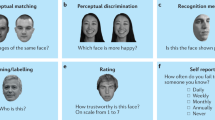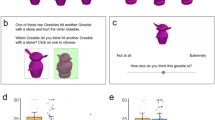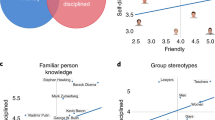Abstract
The belief in physiognomy—the art of reading character from faces—has been with us for centuries1–3. People everywhere infer traits (for example, trustworthiness) from faces, and these inferences predict economic, legal and even voting decisions2,4. Research has identified many configurations of facial features that predict specific trait inferences2,5–14, and detailed computational models of such inferences have recently been developed5–7,15–17. However, these configurations do not fully account for trait inferences from faces. Here, we propose a new direction in the study of inferences from faces, inspired by a cognitive–ecological18–20 and implicit-learning approach21,22. Any face can be positioned in a statistical distribution of faces extracted from the environment. We argue that understanding inferences from faces requires consideration of the statistical position of the faces in this learned distribution. Four experiments show that the mere statistical position of faces imbues them with social meaning: faces are evaluated more negatively the more they deviate from a learned central tendency. Our findings open new possibilities for the study of face evaluation, providing a potential model for explaining both individual and cross-cultural variation, as individuals are immersed in varying environments that contain different distributions of facial features.
This is a preview of subscription content, access via your institution
Access options
Subscribe to this journal
Receive 12 digital issues and online access to articles
$119.00 per year
only $9.92 per issue
Buy this article
- Purchase on Springer Link
- Instant access to full article PDF
Prices may be subject to local taxes which are calculated during checkout




Similar content being viewed by others
References
Hassin, R. & Trope, Y. Facing faces: studies on the cognitive aspects of physiognomy. J. Pers. Soc. Psychol. 78, 837–852 (2000).
Todorov, A., Olivola, C. Y., Dotsch, R. & Mende-Siedlecki, P. Social attributions from faces: determinants, consequences, accuracy, and functional significance. Ann. Rev. Psychol. 66, 519–545 (2015).
Zebrowitz, L. A. Reading Faces: Window to the Soul? (Westview, 1999).
Olivola, C. Y., Funk, F. & Todorov, A. Social attributions from faces bias human choices. Trends Cogn. Sci. 18, 566–570 (2014).
Oosterhof, N. N. & Todorov, A. The functional basis of face evaluation. Proc. Natl Acad. Sci. USA 105, 11087–11092 (2008).
Dotsch, R. & Todorov, A. Reverse correlating social face perception. Soc. Psychol. Pers. Sci. 3, 562–571 (2012).
Todorov, A., Dotsch, R., Porter, J. M., Oosterhof, N. N. & Falvello, V. B. Validation of data-driven computational models of social perception of faces. Emotion 13, 724–738 (2013).
Said, C., Sebe, N. & Todorov, A. Structural resemblance to emotional expressions predicts evaluation of emotionally neutral faces. Emotion 9, 260–264 (2009).
Sutherland, C. A. M., Oldmeadow, J. A., Santos, I. M., Towler, J., Burt, D. M. & Young, A. W. Social inferences from faces: ambient images generate a three-dimensional model. Cognition 127, 105–118 (2013).
Zebrowitz, L. A. & Montepare, J. M. Social psychological face perception: why appearance matters. Soc. Personal. Psychol. Compass 2, 1497–1517 (2008).
Boothroyd, L. G., Jones, B. C., Burt, D. M. & Perrett, D. I. Partner characteristics associated with masculinity, health and maturity in male faces. Pers. Individ. Dif. 43, 1161–1173 (2007).
Montepare, J. M. & Zebrowitz, L. A. Person perception comes of age: the salience and significance of age in social judgments. Adv. Exp. Soc. Psychol. 30, 93–161 (1998).
Secord, P. F., Dukes, W. F. & Bevan, W. Personalities in faces. I. An experiment in social perceiving. Genet. Psychol. Monogr. 49, 231–279 (1954).
Zebrowitz, L. A. in Handbook of Face Perception (eds Calder, A. et al. ) 31–50 (Oxford Univ. Press, 2011).
Todorov, A. & Oosterhof, N. N. Modeling social perception of faces. IEEE Signal Process. Mag. 28, 117–122 (2011).
Walker, M. & Vetter, T. Portraits made to measure: manipulating social judgments about individuals with a statistical face model. J. Vis. 9, 1–13 (2009).
Walker, M. & Vetter, T. Changing the personality of a face: perceived big two and big five personality factors modeled in real photographs. J. Pers. Soc. Psychol. 110, 609–624 (2016).
Fiedler, K. & Wänke, M. The cognitive-ecological approach to rationality in social psychology. Soc. Cogn. 27, 699–732 (2009).
De Houwer, J., Gawronski, B. & Barnes-Holmes, D. A functional-cognitive framework for attitude research. Eur. Rev. Soc. Psychol. 24, 252–287 (2013).
Unkelbach, C., Fiedler, K., Bayer, M., Stegmìller, M. & Danner, D. Why positive information is processed faster: the density hypothesis. J. Pers. Soc. Psychol. 95, 36–49 (2008).
Reber, A. S. Implicit learning and tacit knowledge. J. Exp. Psychol. Gen. 118, 219–235 (1989).
Gordon, P. C. & Holyoak, K. J. Implicit learning and generalization of the “mere exposure” effect. J. Pers. Soc. Psychol. 45, 492–500 (1983).
Bruce, V., Doyle, T., Dench, N. & Burton, M. Remembering facial configurations. Cognition 38, 109–144 (1991).
Cabeza, R., Bruce, V., Kato, T. & Oda, M. The prototype effect in face recognition: extension and limits. Mem. Cognit. 27, 139–151 (1999).
Said, C. P., Dotsch, R. & Todorov, A. The amygdala and FFA track both social and non-social face dimensions. Neuropsychologia 48, 3596–3605 (2010).
Zajonc, R. B. Feeling and thinking: preferences need no inferences. Am. Psychol. 35, 151–175 (1980).
Rhodes, G., Jeffery, L., Watson, T. L., Clifford, C. W. G. & Nakayama, K. Fitting the mind to the world: face adaptation and attractiveness aftereffects. Psychol. Sci. 14, 558–566 (2003).
Reber, R., Schwarz, N. & Winkielman, P. Processing fluency and aesthetic pleasure: is beauty in the perceiver's processing experience? Pers. Soc. Psychol. Rev. 8, 364–382 (2004).
Sofer, C., Dotsch, R., Wigboldus, D. H. J. & Todorov, A. What is typical is good: the influence of face typicality on perceived trustworthiness. Psychol. Sci. 26, 39–47 (2015).
Tabachnick, B. G. & Fidell, L. S. Using Multivariate Statistics 6th edn (Pearson, 2013).
Seo, T., Kanda, T. & Fujikoshi, Y. The effects of nonnormality on tests for dimensionality in canonical correlation and MANOVA models. J. Multivar. Anal. 52, 325–337 (1995).
Dotsch, R., Hassin, R. & Todorov, A. Statistical learning shapes face evaluation: raw data, processed data, and analysis R code. figshare https://dx.doi.org/10.6084/m9.figshare.3563472.v1 (2016).
Dotsch, R., Hassin, R. & Todorov, A. Statistical learning shapes face evaluation: stimuli. figshare https://dx.doi.org/10.6084/m9.figshare.3563514.v1 (2016).
Acknowledgements
The authors are grateful to V. Falvello for her help in data collection, to A. Sklar for early discussions about the work, and to H. Aarts for commenting on a previous version of the manuscript. This research was supported by NWO Rubicon grant no. 446-10-014 awarded to R.D. and United States–Israel Binational Science Foundation grant no. 2013417 awarded to R.R.H. and A.T. The funders had no role in the study design, the data collection and analysis, the decision to publish or the preparation of the manuscript.
Author information
Authors and Affiliations
Contributions
R.D. programmed the studies, analysed data and wrote the manuscript. All authors were involved in study design, discussed the results and edited the manuscript.
Corresponding author
Ethics declarations
Competing interests
The authors declare no competing interests.
Supplementary information
Supplementary information
Supplementary Figures 1–7, Supplementary Methods and Supplementary Results (PDF 507 kb)
Rights and permissions
About this article
Cite this article
Dotsch, R., Hassin, R. & Todorov, A. Statistical learning shapes face evaluation. Nat Hum Behav 1, 0001 (2017). https://doi.org/10.1038/s41562-016-0001
Received:
Accepted:
Published:
DOI: https://doi.org/10.1038/s41562-016-0001
This article is cited by
-
A domain-relevant framework for the development of face processing
Nature Reviews Psychology (2023)
-
Modelling representations in speech normalization of prosodic cues
Scientific Reports (2022)
-
Emotional Faces Facilitate Statistical Learning
Affective Science (2022)
-
A message of the majority with scientific evidence encourages young people to show their prosocial nature in COVID-19 vaccination
Scientific Reports (2021)
-
Sources of confidence in value-based choice
Nature Communications (2021)



